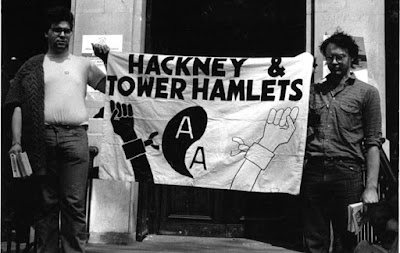JIM CROW LAWS
Source: https://naacpnewbedford.org/2021/04/lynched-yesterday/
In 2015, Walter Scott fled for his life, stalked by a policeman who then cold bloodedly shot him in the back. We all saw the video and in response to this murder I made the artwork, “A Man Was Lynched by Police Yesterday.” This simple banner, printed with the eponymous words, is an update of an iconic flag that the NAACP flew from their national headquarters window in New York in the nineteen-twenties and thirties the day after someone was lynched. It read simply: “A Man Was Lynched Yesterday” and was part of a their anti-lynching campaign — a national effort to end that scourge.
During the Jim Crow era, Black people were terrorized by lynching — often public and publicized extra legal torture and murder of Black people. It was a threat that hung over all Black people who knew that for any reason or no reason whatsoever we could be killed and the killers would never be brought to justice. Now the police are playing the same role of terro
r that lynch mobs did at the turn of the century. It is a threat that hangs over all Black people, that we can be killed by the police for no reason whatsoever; for a traffic stop, for selling CDs, for selling cigarettes. Shot to death, choked to death, tasered to death. Standing still, fleeing. Shot in the chest, shot in the back. Hands up, hands down. Point blank range or at a distance. And the police never face justice for their crimes. Like lynchers in the Jim Crow era, there can be eye witnesses, and now even video evidence, and yet the police get away with murder.
My art often looks at how the past sets the stage for the present but also exists in the present in new form. This artwork is an unfortunately necessary update to address a horror from the past that is haunting us in the present.
Responding to the recent police killings of Philando Castile and Alton Sterling, this updated flag was a last minute addition to For Freedoms at Jack Shainman Gallery in New York (July 2016). It was an unusual, bold, courageous and fitting decision for the gallery to decide to include “A Man Was Lynched…” The art was displayed on the outside of the gallery in a highly visible manner in a way that was evocative of the NAACP presentation. Immediately people responded and initiated a much needed wider conversation, leading to coverage in the New York Times, PBS Newshour Magazine, Fox News, Hyperallergic, Artnet.com and on social media.
There is an epidemic of police killing people. 1,134 stolen lives in 2015 alone. Around the country, people are deeply concerned and taking action—from determined protest shutting down streets to respected athletes, musicians and artists are making powerful statements and art. This is inspiring and needs to grow. I’m glad for A Man Was Lynched by Police Yesterday to be part of the growing dissent and ferment as people act to end police terror.
Source is artist website: https://www.dreadscott.net/portfolio_page/a-man-was-lynched-by-police-yesterday/
BOYCOTTING APARTHEID
The Anti-Apartheid Movement’s local groups gave it a presence all over Britain. Some groups had hundreds of members and links to trade unions, churches and community organisations. Others were kept going by a few dedicated activists.
Anti-apartheid groups campaigned to end British links with South Africa within their local communities. They asked shoppers to boycott South African goods and pressed local branches of supermarket chains like Tesco and Sainsbury’s to stop selling them. They handed out leaflets outside Barclays Bank and Shell petrol stations explaining how the companies supported apartheid. Source link: https://www.aamarchives.org/who-was-involved/local-aa-groups.html
The People’s History Museum in Manchester, England, is the UK’s national centre for the collection, interpretation and study of material relating to the history of working people in the UK and it has a fabulous collection of protest banners from the last 150 years. For any Union members considering how to activate support for radical action in fashion, banner making might be the perfect place to start… It is also an activity that can potentially be combined with a Local Assembly and with the upswing in marches and school strikes, there may be plenty of opportunities to take it onto the streets or certainly adorn our studios, offices and classrooms.
The protest banners at the People’s History Museum combine fabric, stitch, paint, iron-on interfacing, fringe (lots of fringe). The base cloth varies from silk to polyester and cotton. Some are huge, some small.
Below is one image from the website. Website also has banners representing organizations. Go to link to see more. https://concernedresearchers.org/protest-banners-at-the-peoples-history-museum/
Black cotton, lettering and design in iron-on polyester interfacing




No comments:
Post a Comment